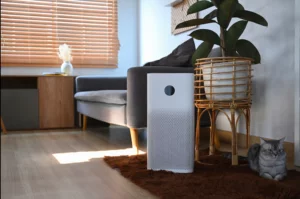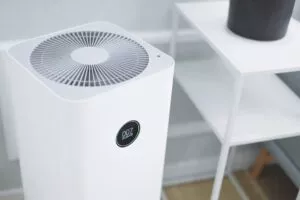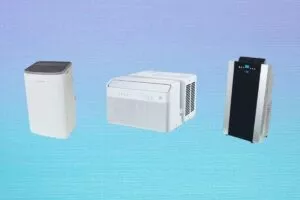
How Do Air Purifiers Work?
Feeling safe at home is not a privilege, but an essential part of life, whether protection from cold, refuge from stress or poor air quality. Considering how much time we spend at home, especially those who work remotely, it is no wonder that home air purifiers become more on-demand devices. Concerns about the air quality inside houses and apartments are rightly justified: exposure to indoor particles and pollutants can cause lung diseases.
However, before you start freaking out about air quality inside your home and click to order yourself an air purifier, take a brief moment to understand how this device works. You can surely rely on it to get rid of some indoor pollutants, yet some factors take away from answering a firm ‘yes’ to a complete air clear out.
Why trust us
Polluted air can be life-threatening. Hence, we are aware of the essential role of an air purifier. But, understanding how a device works, and what a user can expect from its performance, is as important.
That is why while writing this guide, we made sure to analyze what other experts (Good Housekeeping, Filtrete, Healthline and others) have to say. Among those experts are not only air purifier users and reviewers, but also doctors who noticed a drastic change in the health of their patients, who are struggling with asthma or allergies.
How do air purifiers work?
Air purifiers are designed to sanitize the air and remove pollutants, toxins and allergens. (Keep in mind that an air purifier is a different device from a humidifier and essential oil diffuser. (Moreover, those two add particles to the air.) Typically, an air purifier is a portable device that can be found in both large and compact sizes. The device combines a fan and an internal filter. The fan pulls in unwanted particles from the air. It goes through the filter and circulates back into the room in a purified condition. Depending on how often you turn the air purifier on, the filtration process repeats several times an hour.
However, the type of removed particles depends on the type of air purifier. There are some you can buy with built-in filters to trap particles. Other types can only neutralize pollutants without filtering.
Speaking of filters, you would have to replace them based on the type of a purifier. Some of those filters are reusable, yet they require regular maintenance. Besides removing harmful particles from the air, dust and pollen, some UV filters destroy biological impurities like mold or bacteria.
Other types of air purifiers use ionizers to catch static which creates negative ions that bond to dust and allergens and make them settle in the air. Still, they have some downsides. If you are looking to buy an ionized air purifier, double-check that it does not produce a dangerous level of ozone. When increased, ozone can cause lung irritation or aggravate asthma conditions.
What exactly are air purifiers fighting with?
The effectiveness of air purifiers is undeniable. However, they do not remove all particles in the air only because many of those reside on furniture, bedding and carpets. Yet, what it can do is impressively powerful.
1. Air purifiers can fight mold
Indoor mold particles are dangerous for overall health, especially for those with asthma and lung diseases. That is when air purifiers with a HEPA filter are the best solution simply because an air purifier without a filter is not as effective in getting rid of mold in the air as the one with a filter.
2. Air purifiers can remove allergens
The danger of allergens is that excess of them in the air can create conflicting immune responses such as asthma or allergies from mild to severe ones (dust mites, pollen and others). As a comparison between a standard air purifier and the one with a filter, the latter is more effective in trapping allergens.
3. Filtrating of indoor toxins
Cleaning products, hair spray and other personal care products cause indoor toxins, which in the end can be harmful to your health. Air purifiers successfully trap indoor toxins, reducing their harmful impact.
4. Smoke removal
Those air purifiers that contain filters can remove smoke from the air, including tobacco smoke. Although it won’t get rid of the smell completely, you will notice a significant difference when using an air purifier while frying or smoking.
Speaking of smoke, if you live in an area that is affected by wildfires, you might want to consider buying an air purifier. Even if your area only faces mild consequences of wildfire in form of smoke and smell, particles of it can produce carbon monoxide, nitrogen oxides, and VOCs.
Those gases and particles are damaging when inhaled, hence an air purifier can be a solution to reduce those the polluted air that entered living spaces with smoke. It is also recommended to choose an air purifier with HEPA filters to lower, trap and neutralize the concentration and harm of smoke remnants.
What about outdoor air?
There is no way to avoid outdoor air entering your living space through open doors or windows. While an air purifier would be useful in any household, it is especially recommended for those who live in an area affected by pollution. Poor-quality outdoor air can also be harmful to people with asthmatic symptoms or allergies. Some air purifiers can filter environmental air qualities reducing large particles that could be health concerns.
What are the benefits of an air purifier?
An air purifier removes a source of symptoms of allergies and asthma, prevents aggravating particles from getting into your home, and that perhaps is the most significant benefit. However, it is not the only one.
A few other benefits of having an air purifier at your home are eliminating harmful chemicals from the outdoor environment, neutralizing unpleasant odours and smoke, and removing hazardous asbestos particles. All those factors combined can increase life expectancy and improve overall health.
What air purifiers cannot do?
The most important fact to remember is that an air purifier is not as effective on its own as one with a filter. Another one is that a small portable air purifier is not powerful enough to clear air in an entire place (unless it is a small apartment). Hence, if you have a spacious place, you might have to invest in a larger air purifying system or a few portable devices for each room.
Another factor is that air purifiers cannot do all the work of cleaning the air in your home. The device only removes particles in the air, but you have to take care of those that lay on surfaces around your home.
(A few tips to prevent harmful particles from laying around on furniture, upholstery and carpeting:
- Clean rugs and carpeting often with a HEPA filter vacuum.
- If possible, replace carpeting with vinyl or hardwood flooring.
- Wash bedding at least once a week.
- Make sure that your home is at the right humidity level.
- Stay away from smoking inside the house.)
Can a DIY air purifier be effective?
If you are still contemplating whether your space needs an air purifier or looking for a DIY project, you could try making it by yourself. Shortly, you would need a box fan and a HEPA filter. You can either make an air purifier with a fan and one filter or use a double filter setup over the fan.
The only downside to homemade air purifiers is that their motor has to work much harder than a factory-built one, hence the risk of fire increases.
In case you would like to learn how to build a DIY air purifier, we just pasted below a tutorial YouTube video by the folks at Wirecutter.
Read more

The Best Portable Air Conditioners in Canada
These portable AC units are chill.

The Top Smart Air Conditioners
When summer hits, stay cool with the best AC units.

The Best Blenders in Canada
We searched high and low, and here are the best blenders available for any budget.

The Best Rice Cookers in Canada
A worldwide staple, rice is the perfect side to any dish. Cook it perfectly everytime with this selection of rice cookers.